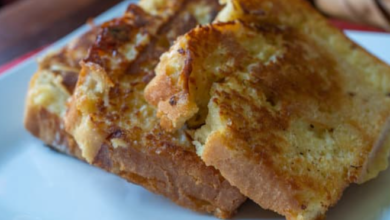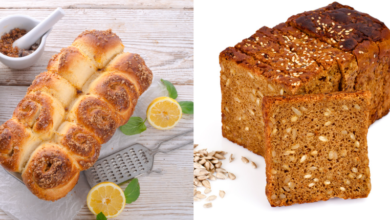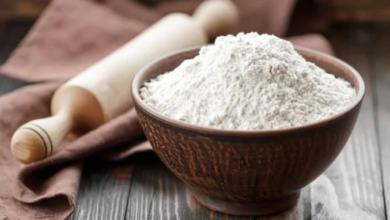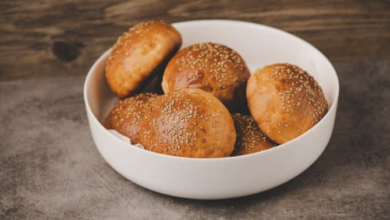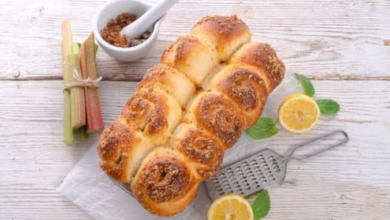Baguette Vs Brioche: How To Decide Which One Is Right For Your Needs
What To Know
- It can be sliced and toasted for French toast or bread pudding, stuffed with savory fillings for sandwiches, or used as a base for desserts like pain perdu.
- Whether you prefer the simplicity of a baguette or the decadence of a brioche, both breads deserve a place in every bread lover’s repertoire.
- What is the difference between a baguette and a French bread.
In the culinary arena, two bread titans stand tall: the baguette and the brioche. Both hailing from France, these delectable delights offer distinct flavor profiles, textures, and purposes. In this blog post, we delve into the captivating world of baguette vs brioche, exploring their origins, characteristics, and the culinary versatility that sets them apart.
Origins and History
Baguette: The Staff of Life
The baguette, with its elongated shape and crispy crust, has been a staple of French cuisine since the 19th century. Its humble beginnings can be traced back to the bakeries of Paris, where it was initially known as the “pain de deux sous” (two-penny bread) due to its low cost. Today, the baguette remains a symbol of French culture, enjoyed by locals and tourists alike.
Brioche: The Bread of Luxury
Brioche, on the other hand, emerged in the 16th century as a bread of opulence. Its rich, buttery flavor and soft, fluffy texture were reserved for the wealthy and elite. The name “brioche” is believed to derive from the Norman word “broyer,” meaning “to knead,” reflecting the intricate process involved in its creation.
Physical Characteristics
Baguette: Crispy on the Outside, Chewy on the Inside
The baguette is renowned for its long, slender shape, typically measuring around 60-70 centimeters. Its exterior is characterized by a golden-brown crust that shatters upon the first bite, revealing a chewy and airy interior. The crust provides a satisfying crunch, while the crumb offers a subtle sourdough tang.
Brioche: Soft and Fluffy, with a Golden Hue
Brioche is a round or loaf-shaped bread with a distinct golden-brown color. Unlike the baguette, it has a soft and fluffy texture from end to end. The high butter content results in a rich, buttery flavor that lingers on the palate.
Nutritional Value
Baguette: A Leaner Option
Baguettes are relatively low in calories and fat compared to other types of bread. They provide a moderate amount of carbohydrates and protein, making them a good choice for those seeking a balanced diet.
Brioche: Rich and Indulgent
Brioche, with its high butter content, is richer in calories and fat than baguettes. It also contains a higher proportion of carbohydrates and a lower amount of protein. While it may not be the healthiest bread option, brioche offers a decadent treat for special occasions.
Culinary Versatility
Baguette: A Culinary Workhorse
The baguette’s versatility extends from breakfast to dinner and beyond. It can be sliced and toasted for sandwiches, used as a base for open-face tartines, or simply enjoyed on its own. Its crusty exterior makes it a perfect companion for soups, stews, and salads.
Brioche: A Sweet and Savory Delight
Brioche is equally versatile, though its rich flavor and soft texture lend it to both sweet and savory applications. It can be sliced and toasted for French toast or bread pudding, stuffed with savory fillings for sandwiches, or used as a base for desserts like pain perdu.
Which Bread to Choose?
The choice between baguette and brioche ultimately depends on personal preference and the intended use. If you seek a crunchy, lean bread for everyday meals, the baguette is an excellent option. If you desire a soft, buttery bread for special occasions or indulgent treats, brioche is the perfect choice.
Key Points: A Tale of Two Breads
Baguette and brioche, two iconic French breads, each possess unique characteristics and culinary applications. The baguette, with its crispy crust and chewy interior, embodies the rustic charm of French cuisine. The brioche, with its soft, fluffy texture and rich buttery flavor, represents the indulgence and opulence of French baking. Whether you prefer the simplicity of a baguette or the decadence of a brioche, both breads deserve a place in every bread lover’s repertoire.
Basics You Wanted To Know
1. What is the difference between a baguette and a French bread?
While baguettes are a type of French bread, not all French bread is a baguette. Baguettes are characterized by their long, slender shape and crispy crust, while other French breads may have different shapes and textures.
2. Is brioche a healthy bread?
Brioche is not as healthy as some other types of bread due to its high butter content, which increases its calorie and fat content. However, it can be enjoyed in moderation as part of a balanced diet.
3. Can I make baguettes or brioche at home?
Yes, it is possible to make baguettes and brioche at home. However, it requires some skill and practice to achieve the desired texture and flavor. There are many recipes and tutorials available online to guide you through the process.
4. What are some popular fillings for brioche sandwiches?
Popular fillings for brioche sandwiches include ham and cheese, smoked salmon and cream cheese, and brie and apple.
5. How can I store baguettes and brioche to keep them fresh?
Baguettes and brioche can be stored at room temperature for a few days. To extend their shelf life, store them in an airtight container or wrap them in plastic wrap and freeze them for up to a month.
